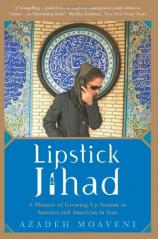Reading Group Guide
Discussion Questions
Lipstick Jihad

1. In the introduction to the book, the word jihad is translated as "struggle". Why do you think the title of the book is "Lipstick Jihad"? Do you like the title? Why or why not?
2. Most of Azadeh Moaveni's family arrived in America just before or with the 1979 revolution. They view themselves as exiles rather than immigrants [p. 28]. What effect does this sensibility have on their sense of identity and their need to assimilate?
3. At the beginning of the book, Azadeh is in many ways a typical teenager, trying desperately to fit in with her peers. She is embarrassed by her Iranianness, especially in the wake of the hostage crisis. She feels caught between two irreconcilable cultures --- those of her Persian home and her American school. By college, however, she sheds her efforts to cultivate a certain "ethnic ambiguity" [p. 10] and instead embraces "the joys of my own private Iranianness" [p. 28]. How does of her sense of her own identity change once she moves to Iran?
4. Upon arriving in Iran, Azadeh realizes that growing up on the "outside" came with many complications: "You grew up assuming everything about you was related to that place, but you never got to test that out . . . You spent a lot of time . . . feeling sad for your poor country. Most of that time, you were actually feeling sorry for yourself, but since your country was legitimately in serious trouble, you didn't realize it." [p. 32] To what extent do hyphenated Americans use questions about cultural origins as a cloak to conceal deeper uncertainties about themselves and their values?
5. Azadeh decides that in order to portray Iran's young generation faithfully, she needs to live among them and like them. "I cannot write about them without writing about myself," she writes [p. xi]. If an author becomes part of the story she is writing, does she lose her ability to report objectively? Where in the book does the tug between objective reporting and Azadeh's subjectivity as an Iranian woman reveal itself?
6. Azadeh describes the rebellion of Iranian youths as various "as if" behaviors [pp. xi, 55, 62]. What does she mean? Do these behaviors have "real" effects?
7. Throughout the book, Azadeh's perceptions about Iran and its future shift dramatically. In one moment, she calls Iranian society sick, "spiritually and psychologically wrecked," [p. 101] while at other times she discusses the revolution's accidental achievements, including the higher literacy for women and the growing secularism of the middle class. What does this see-sawing in tone between despair and hope reflect about Iran?
8. The Iranian diaspora in America is enamored with an Iran that is no more. As Siamak tells Azadeh: "If you are a nostalgic lover of Iran, you love your own remembrance of the past, how the passions in your own life are intertwined with Iran." [p. 45] How does this nostalgia and sense of personal grievance affect what Iranian-Americans teach Americans about their changing country?
9. In Chapter 3, Azadeh writes: "Made neurotic by the innate oppressiveness of restrictions, Iranians were preoccupied with sex in the manner of dieters constantly thinking about food." [p.71] How does the culture of the revolution affect relations between the sexes in Tehran? How does Azadeh respond to the gender gap she observes around her?
10. At a press conference for President Khatami at the U.N., Azadeh struggles over her decision to wear the veil. [pp. 169-172] Why is the decision so difficult?
11. In "Love in a Time of Struggle", Azadeh writes that romantic relationships between men and women "served a far more vital purpose: taking a fragile identity and anchoring it in a situation or person." In Iran, one has to find a partner who wants "the same sort of Islamic Republic experience." [p. 179] Whom does Azadeh look to to help anchor her identity? Do they share a vision of their Islamic Republic experience? Why or why not?
12. How do the twin stories of Mira and Fatima reveal the restrictions women face in Iranian society? Since the traditional Fatima lacks the opportunity to establish her independence and ultimately gives up her job for an arranged marriage, was she truly served by the education the revolution made possible for her? In the end, does consciousness of her rights enhance her life, tied as she is to her conservative family, or does it make its limitations more painful?
13. How does the beating that Azadeh receives during the riot of "the summer of the cockroach" affect the way she sees Iran? How does the ever-looming prospect of violence affect the populace of Iran in general?
14.What finally pushes Azadeh to leave Iran?
15. After Sept. 11, Reza tells Azadeh, "There's no outrage in the West when we die, no one talks about civilian deaths, because by now our loss of life is ordinary." [p. 224] Even though Iranians are described throughout the book as markedly pro-American, do the reactions Azadeh describes to Sept. 11 suggest a deeper ambivalence about America's intentions and presence in the Middle East?
16. Young people are described as changing Iran from below, when "at some historic moment impossible to pinpoint, around the turn of the millennium, Iranians' threshold for dissimulation and constriction sank, and people simply began acting differently." [pp. 61-62] At the same time, Azadeh chronicles young people's apathy at the failure of the reform movement. How important can young people be to Iran's future once apathy has set in? Can a society truly be changed through how people live daily life, from the bottom up?
17. Lipstick Jihad is about the search for home. At the end of the book, where is home for Azadeh Moaveni?
Lipstick Jihad
- Publication Date: March 28, 2006
- Paperback: 272 pages
- Publisher: PublicAffairs
- ISBN-10: 1586483781
- ISBN-13: 9781586483784







